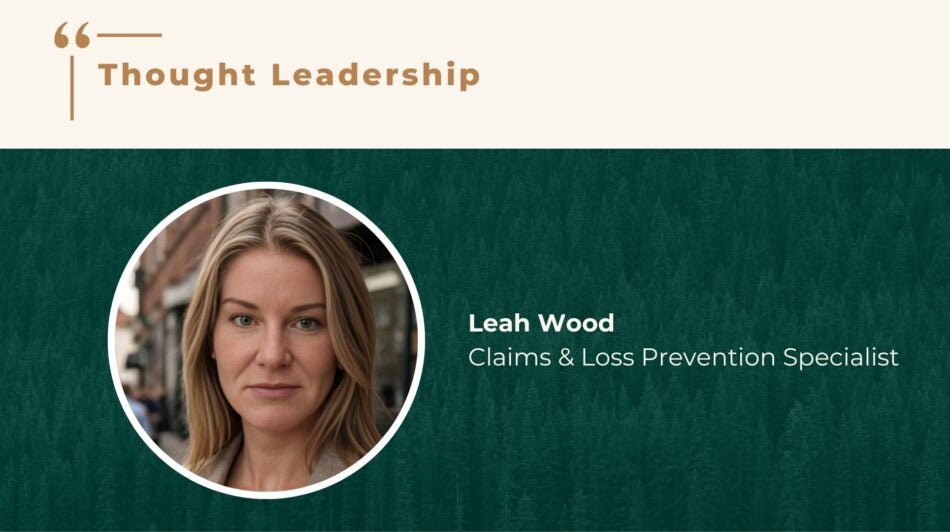Addressing cognitive bias to effectively manage risk
Prevention is the foundation of effective risk management; it’s also the first line of defence in claims administration.
In fact, 90% of predictable risks are preventable. This statistic emphasizes the importance of actively identifying and addressing predictable behaviours and practices that could lead to hazards or losses.
The challenge is, when considering risk in a broader or more expansive sense, we often struggle with cognitive biases that cloud our judgment and influence our decision-making.
To effectively assess and mitigate risk, it’s crucial to adopt a systematic approach that addresses and overcomes these biases and promotes preparedness for both catastrophic events and smaller, ongoing losses.
By reframing the conversation around risk, we can recognize that practicing risk management doesn’t require specialized expertise; rather, it often involves simple behavioural changes instead of costly system upgrades.
Transitioning from ignoring to preparing for inevitable risks
There is a great book called The Ostrich Paradox: Why We Underprepare for Disasters, which reflects the tendency to underestimate or ignore risks, parallel to the idiom of burying one’s head in the sand.
Addressing the ostrich paradox requires a logical approach to overcoming cognitive biases so to empower individuals, communities and institutions to better prepare for both catastrophic events and ongoing losses.
Using the six key cognitive biases outlined in the abovementioned book, let’s explore some examples to illustrate this concept.

Myopic bias: Unwillingness to assume costs for uncertain events.
For an example of the myopic bias, assume that a business focuses its continuity plans on traditional threats such as natural disasters or physical security breaches, while overlooking the potential impact of cyberattacks or data breaches. They may believe that the costs to implement software updates, train employees on phishing awareness or building robust network encryption is not worth the cost as there is no immediate return.
In this scenario, the company’s myopic bias towards traditional threats may lead to an underestimation of the likelihood and potential severity of cyber-related incidents.

Amnesia bias: Quickly forgetting lessons from past disasters
For an example of the amnesia bias, imagine a manufacturing facility experiences a significant decrease in workplace accidents over several months due to the successful implementation of safety procedures and training programs. As a result, management may gradually reduce the frequency of safety inspections, training sessions and equipment maintenance, believing that the risk of accidents has been effectively mitigated.
The amnesia bias towards past successes can lead to a false sense of security and neglect of ongoing safety measures.

Optimism bias: Believing it ‘won’t happen to me’
I believe this is the riskiest cognitive bias when helping a client prepare for a loss. For example, during a risk inspection, I identified numerous areas of weakness and provided suggested options for improvement. Yet, the policyholders and ownership group dismissed the need for action based on the building’s lack of prior incidents, setting aside its advanced construction age.
During the inspection I, on crutches and a full-leg cast, shared a personal story of injury despite feeling invincible due to my lack of prior incidents, illustrating how optimism bias can lead to neglecting essential precautions.
The optimism bias can lead to unwarranted risk-taking and a failure to prepare for potential negative outcomes, ultimately causing financial instability and hardship.

Inertia bias: Avoidance at all costs
When confronted by a threat — especially one we have never experienced before — or something we don’t want to think about, our natural reaction is to do nothing.
An example of inertia bias is the resistance of established taxi companies to embrace ride-sharing services like Uber and Lyft. Despite the convenience and efficiency offered by these platforms, traditional taxi companies initially resisted adopting similar technology and business models, failing to accept variation with an open mind.
This inertia stemmed from their longstanding dominance in the transportation industry and reluctance to change their established practices. As ride-sharing services gained popularity among consumers, however, taxi companies faced declining revenues and market share, highlighting the consequences of inertia bias in adapting to technological advancements and changing consumer preferences.

Simplification bias: Looking for short cuts to make things easier
When it comes to risk management, the simplification bias may result in a few important actions being completed, but other critical protective measures being left incomplete.
Consider a homeowner who lives in an area prone to wildfires. They take one step to prevent catastrophic loss by purchasing homeowner insurance to cover potential damages to their property in the event of a wildfire; however, they neglect creating a defensible space around their property by clearing brush and vegetation or investing in fire-resistant materials for their home.
As a result, when a wildfire approaches their area, the homeowner’s property is at greater risk of damage or destruction due to the lack of proactive measures to mitigate the impact of the fire.

Herding bias: Imitation comes with risky limitations
When a client makes insurance decisions based on what coverage or loss prevention methods their neighbour has, rather than consulting with a broker, we can have problems.
Herding bias in insurance can be observed when individuals make decisions based on the actions of others, rather than independently assessing risks or opportunities. For example, if a particular insurance company gains popularity due to positive reviews or media attention, individuals may flock to that insurer without thoroughly evaluating their own needs or comparing options. This can lead to a situation where people follow the crowd, potentially overlooking better-suited coverage options for their specific circumstances.
This herding behaviour can lead to the spread of misinformation, as individuals prioritize conforming to the crowd over critically evaluating the accuracy or validity of the information being shared.
By reinforcing that keeping it simple and acknowledging our inherent biases can help us better evaluate potential threats objectively and put ourselves in a stronger position to manage risk effectively.
Awareness is prevention
Through education and advocacy, we strive to equip individuals, communities and institutions with the tools and knowledge needed to navigate the complexities of risk management effectively.
While overcoming these hurdles may take time, bringing this level of awareness to our clients can significantly reduce the likelihood of claims resulting from avoidable incidents.
Our goal as brokers is to help reshape the conversation about risk in a way that helps clients truly understand climate and behavioural threats they face.
People are more willing to participate in change after something negative happens. Negative events often serve as catalysts for change, prompting greater willingness to participate in preventive measures.
But effective risk management is about mitigating the likelihood of negative outcomes. To be effective, risk management cannot wait for an unfortunate — and preventable — loss to spur our willingness to change our behaviours.
So, what can brokers do to support our clients?
Let’s get inspired by looking at some highly successful awareness campaigns that been effective in significantly reducing risk:
- Mothers Against Drunk Driving (MADD), which, through their marketing efforts, managed to reduce alcohol-related accidents by 50%, as reported by the National Highway Safety Administration.
- Smokey the Bear, an iconic character whose message that we each play a role in preventing wildfires is just as relevant today as when the campaign first launched in 1944.
- #BellLetsTalk, a brilliantly simple and effective campaign that encourages people to talk about mental health on one day to normalize and destigmatize the conversation. As a result, 83% of Canadians reported believing attitudes about mental illness have improved since Bell Let’s Talk began.
What these campaigns have done so effectively is to connect people emotionally and intellectually to negative outcomes, making them more open to embrace change when faced with adversity.
Additionally, these campaigns work because they:
- Acknowledge everyone must take personal responsibility in mitigating risks.
- Clearly outline cause and effect — meaning it’s more difficult to keep our head in the sand or underestimate risks.
Awareness campaigns often seek to educate the public about a particular issue, raising consciousness and encouraging behavioural change. Similarly, overcoming cognitive bias involves recognizing and mitigating the impact of mental shortcuts and irrational patterns of thinking that can lead to less-than-optimal decisions.
Much like awareness campaigns, effective risk management requires a concerted effort to challenge existing beliefs and habits, as well as promote critical thinking and self-reflection to empower our clients to make more informed, rational choices.
Navigate the ever-evolving landscape of risks with confidence
By shining a light on these cognitive blind spots, brokers, individuals and organizations can bolster their capacity to evaluate risks with greater accuracy and make well-informed decisions accordingly. This, in turn, facilitates the development of more focused and effective risk management strategies, positioned to address the specific biases at play.
By methodically dissecting and analyzing cognitive biases, decision-makers are better equipped to navigate potential pitfalls and steer towards more rational and data-driven approaches to risk assessment and mitigation.
Moreover, engaging stakeholders in discussions about risk by storytelling and examining case studies offers a dynamic platform for exploring the complexities of risk management in real-world contexts.
Unpacking the narratives behind past losses and studying the factors that contributed to them, stakeholders gain invaluable insights into the complex nature of risk. This process not only cultivates a deeper appreciation for the intricacies of risk management but also adds to stakeholder’s tool kits to actively participate in crafting tailored strategies to mitigate future risks.
Continuous improvement and adaptation allow us to all navigate the ever-evolving landscape of risks with greater confidence and responsiveness, achieving improved outcomes and sustained success.
Leah Wood, Claims & Loss Prevention Specialist, brings a wealth of expertise to the table, ensuring that Acera Insurance clients receive top-notch guidance in safeguarding their assets and mitigating potential risks. She is committed to proactive strategies and closely collaborates with clients to navigate complexities with precision to ensure superior protection and service.

